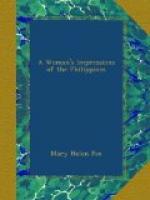About a week after our open session I was about to retire one night, when I heard the sound of music and saw lights approaching. Transparencies were waving about in the warm air. As there was no cholera, and therefore no occasion for a San Roque procession, I hung out of the window, local fashion, to find out what it was all about. It was a newly organized parliamentary society parading. In less than a month three new societies had blossomed among the youths and old men of the town. American teachers were engaged as parliamentarians, although the societies were conducted in Spanish, not English. The societies all died a natural death in a little while; but of course, the school society being compulsory could not die, and so far as I know is still going on. Every public school of the secondary class has its school societies, and they must form the ideals of the new generation.
One of the most irritating features of life in those early days, and one which offered a problem rather difficult for the Government to solve, was the matter of currency. The money in use was silver, with a small paper circulation of Banco Espagnol-Filipino notes. The notes were printed on a kind of pink blotting paper which looked as if it would be easy to counterfeit. The silver was what we called at first “Mex” and later “Dobie.” There were some pieces coined especially for the Philippines, but in general “Mex” was made up of coins of Spain, Mexico, Islas Filipinas, Hong-Kong, Singapore, Canton, and Amoy—only the experts of the Government could tell where it all came from. With the public at large, any coin that looked as if it contained the fair average of silver was accepted. Every month the paymasters of the United States Army and Navy issued thousands of dollars in American silver and paper, but this disappeared in a twinkling, swallowed up by the local agents who were buying gold with which China paid her indemnity. Each incoming steamer brought loads of “Dobie” from the Asiatic coast, but our good dollars and quarters went out of sight like falling stars.
The silver coins consisted of pesos, medio-pesos, pesetas (twenty-cent pieces), media-pesetas (ten-cent pieces), and it seems to me that I have a hazy recollection of a silver five-cent piece, though I cannot be certain. The copper coins were as mongrel as the silver.
There were English, Dutch, Spanish, and Chinese coins from the neighboring coasts, but the greater part of the copper coins consisted of roughly pounded discs with ragged edges, which were made, they said, by the Igorrotes. The coins had no inscriptions, but went with the natives by the name of “dacolds”—the native word for “big,” The Americans renamed the dacolds “claquers,” and used either name at pleasure. It required eighty dacolds to equal one peso, forty to a half-peso, sixteen to a peseta, eight to a media-peseta. Theoretically a peso was a hundred cents, as a peseta was twenty cents, but there was no cent with which to make change. You accepted the dacold at its value of eighty to a peso, or you transacted no business. The Filipinos also had a way of figuring a medio-peso as cuatro reales, thus giving the real a value of twelve and a half cents, though there was no coin called a real. Nevertheless, the real figured in all business transactions.




